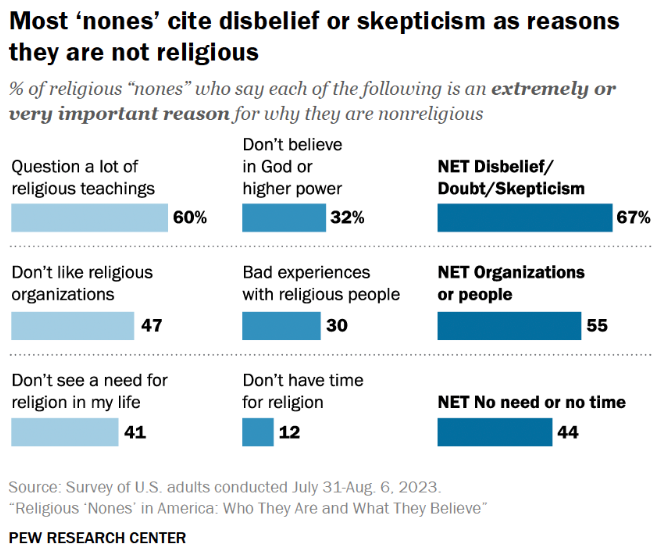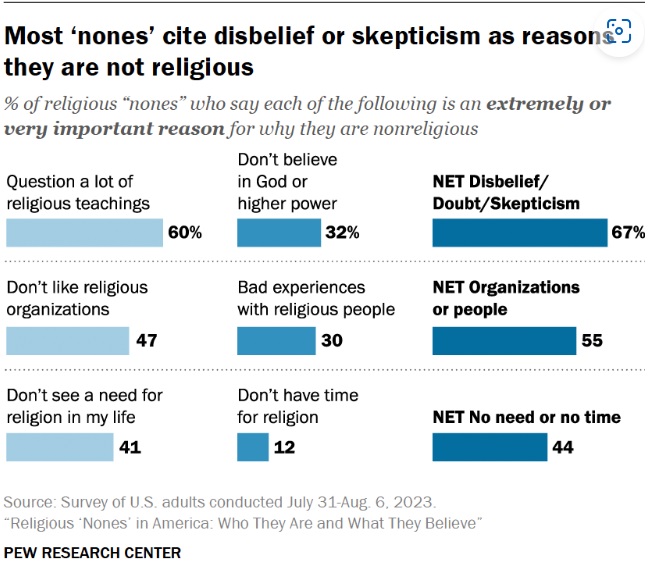A Challenge to Churches: Reaching the “Nones”, the New Non-Religious Majority
- Abigail Caress

- Feb 1, 2024
- 3 min read

Newly released 2023 data from the Pew Research Center’s National Public Opinion Reference Surveys found that 28% of US adults are religiously unaffiliated “nones”, unseating the former majority held by Evangelicals (now 24% of the overall population). When I was growing up in the 1980s, this "nones" group was only at about 5-6%. Most of these nones are not atheists – far from it. Most classify themselves as generally ‘spiritual’ or agnostic. They have the sense of a higher power and are even curious about the potential of a supernatural being or beings.
(Image credits below: Pew Research)
It’s safe to say from these findings (and many more showing churchgoer attrition rates overall) that in the recent decades, the Evangelical church and churches in general have failed to engage and offer hospitality to those with doubts. How do we know?
60% of them give the answer that they “question a lot of religious teachings” as the extremely or very important reason why they are nonreligious. 60%!
It’s not hard to read between the lines to find in that percentage a lot of valuable conversations that never happened—or happened with a combative and judgmental tone. The rest of the data practically spells it out: 47% of the nones confessed that they “don’t like religious organizations” and 30% shared specifically that they’ve had “bad experiences with religious people”.
WHAT ARE CHURCHES TO DO?
What are churches to do with the knowledge that nearly one-third of our population doesn’t like them and doesn’t trust them?
What are churches to do with the knowledge that nearly one-third of our population doesn't like them and doesn't trust them?
It starts with good outward-facing communication that builds trust in two ways:
Transparency in Communications and Leadership – Does your church openly share its plans, opportunities, events, and information about group meetups? Does it make it easy to receive feedback from the neighborhood community about their needs and concerns? Does it model its values by building its partnerships in the community and celebrating those partnerships? How available is your pastoral staff to answer questions? Do your pastoral staff and leadership share their vision with everyone openly? Is it articulated well so others can share it? Can volunteers voice their ideas for improvement and be met with support? Are these communication loops well articulated on your website, social media, and by click-through communication portals so that questions can be asked and answered in response to what you post, offer and share?
A Neighbor-Loving Mission – Many churches own the Great Commission as their mission on their websites. Well and good. But how did the early church begin to accomplish this very important mission? Look at Acts 2, where they supported their neighbors by giving generously to support those in need, often sharing meals in their neighbors’ homes. Loving community is what spread the gospel, a posture that what won hearts over and gave the baby church “favor” in the eyes of “all the people” so that thousands were becoming baptized (Acts 2:47). In an era when the Evangelical church has been full of scandals and its “culture warrior” approach made outsiders feel like very unwelcome opposition, becoming a place of love and commitment to community is vital to restoring broken trust and repairing the wounds other congregations (or your own!) may have given to your nones-neighbors.
Church leaders today are positioned well to make a great restoration movement despite the odds. This cultural shift towards a nones-majority gives churches the opportunity to really reassess and root out their old closed-communication models, ideologies and fear-based mindsets that have twisted up the tree of faith and led to the loss of good fruit.
To learn more on how to build an outward-facing communication model and see a specific checklist I have made for churches, click here.
Abigail Caress formed her own small communications and marketing business in 2023 to help create efficient promotion and information flow for small businesses, nonprofits, and churches. Building on 14 years of experience in an array of nonprofit administration and communications roles with an intense focus on churchwork as both a pastor’s wife and church communications manager, Abigail enjoys exploring the intersection of mission and model with her church clients.








Comments